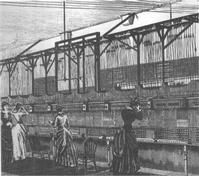


Chapter 8
I Part 1: Communications
i Before the Telegraph
ii Electrical Communication Before Federation
iii Federation to the End of the Second World War
iv Post-war and on to 1975
v 1975 ONWARDS
II Epilogue
III Part 2: Early Australian Computers And Computing
IV Acknowledgements
References
Index
Search
Help
Contact us

Electrical Communication Before Federation (continued)
All the early lines were single wire construction with return connection through the earth, a system which produced two operational problems. There was 'cross talk' where lines closely paralleled one another, and weather conditions, which can cause electrical currents to flow in the earth, at times produced severe interference to the telegraph signals. The 'leakage problem', as it was known, was another major limitation in the performance of the overhead lines as even with well designed insulators in good condition with, say, 30 poles to the mile, there were 15,000 leakage paths in parallel on a 500 mile section. This was found to be the practical upper limit to the length of a line before a repeater was necessary, initially in the form of an operator who received the incoming message, wrote it down and then transmitted to the line on the other side of the repeater. Suitable locations for staffing purposes were thus another factor in determining the location of repeaters and in practice, repeater sections were in the range of 300 to 500 miles.The second half of the 19th century was the era of the inventors and in Europe and the US inventors worked to devise equipment to overcome factors limiting the telegraph service. As a skilled operator using a simple Morse key could send only 30 words per minute, one approach was to produce equipment which increased the sending rate, while another was to develop more sensitive receiving equipment. Australian engineers and managers kept a close watch on inventions which were rapidly improving the service in North America and Europe and used a selection process which often involved trials of new items under Australian conditions. Double current working, duplex operation, tape machines which allowed messages to be punched on tape and then sent to line at higher speeds, automatic repeaters, were all introduced and increased traffic capacity quite substantially. On the device side, items of equipment, such as the polar relay marked the increasing sophistication of telegraph technology.
The second outcome of theoretical and practical work on electricity and magnetism was the telephone, first demonstrated by Bell in Boston, USA, in 1876. As Bell published technical details of his invention in a number of scientific papers in 1877, Australian inventors soon produced their own instruments using local materials. However, as certain key details such as diaphragm thickness, air gap and winding details were not specified, several pairs of telephones might have to be made before the best values were found. Experiments with these and imported instruments were carried out in the various Australian colonies over telegraph lines and examination of records of the time suggest that the first experiments which could be described as successful were achieved early in 1878.
The first telephone service in Australia was installed in 1879 by Robinson Brothers, connecting their Flinders Street Office to their South Melbourne works. Other point to point services followed quickly, but the real potential of the telephone depended on a facility to cross connect from one service to another. This was provided quite soon by the invention of the exchange, the first of which was installed in Connecticut, USA, in 1878 and two years later an exchange was opened for business in Melbourne and by 1883, only West Australia did not have an exchange service in its capital city.[8]

 |
Australian Academy of Technological Sciences and Engineering |  |
© 1988 Print Edition page 536, Online Edition 2000
Published by Australian Science and Technology Heritage Centre, using the Web Academic Resource Publisher
http://www.austehc.unimelb.edu.au/tia/530.html